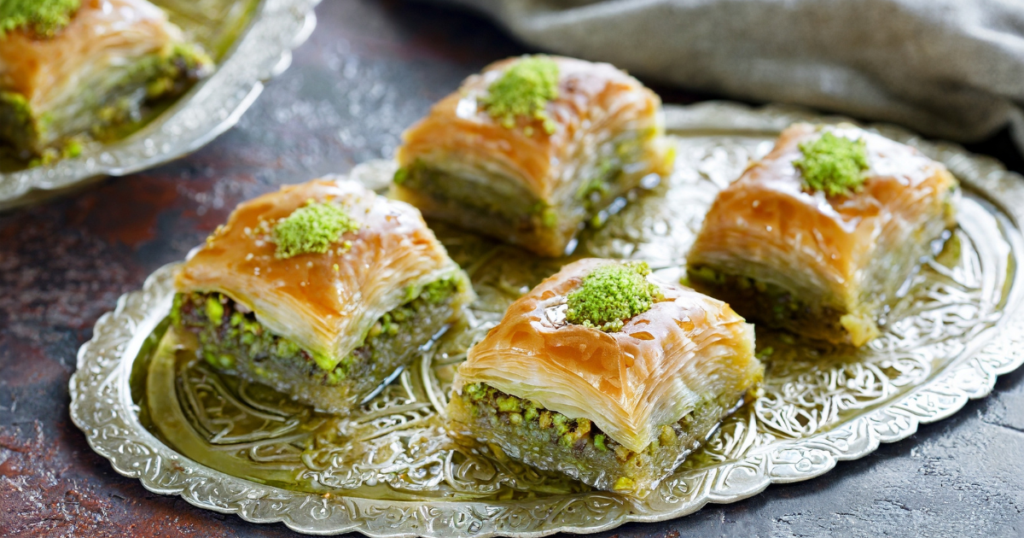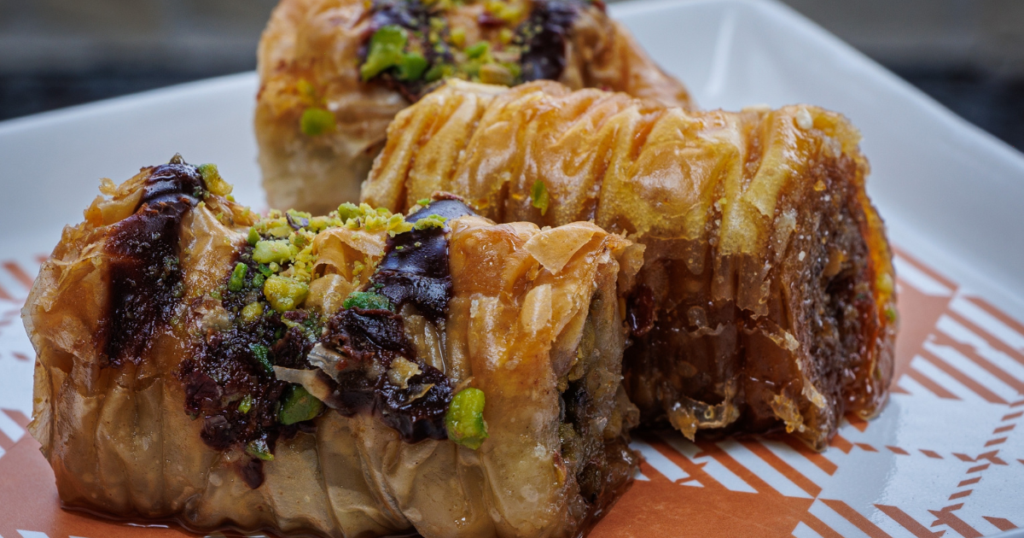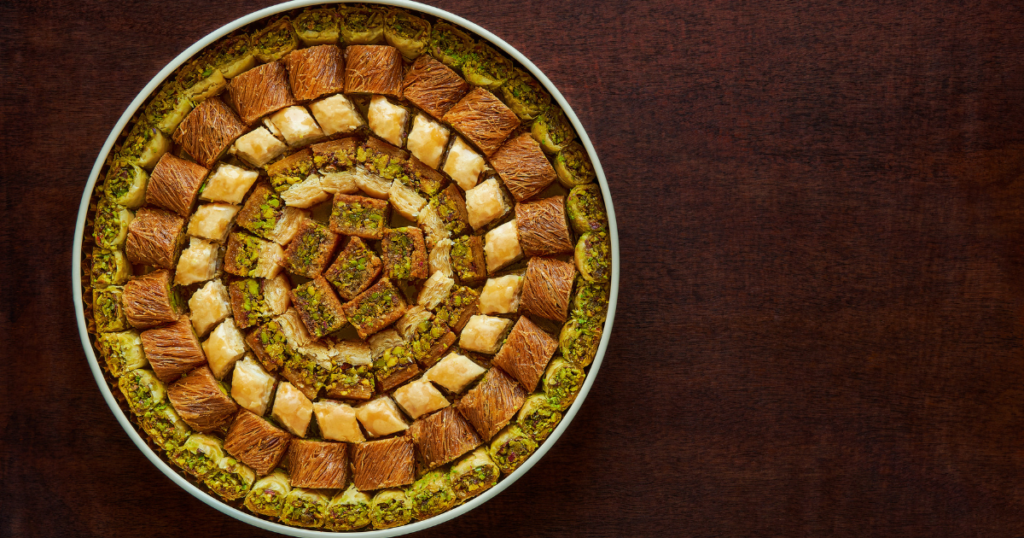Baklava, a dessert synonymous with indulgence, is a timeless treat that has delighted taste buds for centuries. Known for its flaky, golden layers of phyllo dough, aromatic nuts, and sweet honey or syrup, baklava has transcended borders and become a beloved dessert worldwide. Its origins, however, are as layered as its pastry. Claimed by multiple cultures and countries, the history of Baklava is one of shared heritage and culinary evolution, making it a true global delight. Thanks to social media, in recent times, the dessert has become popular among all age groups amongst people who had earlier not even heard of the same. Now, the ease of food availability due to networking and online food delivery platforms has made possible for everyone to taste food from any corner of the world.
The Ancient History of Baklava Origin
Baklava’s history can be traced back to ancient civilizations in the Mesopotamian region. The earliest references to a dessert resembling baklava date back to 8th century BCE, where Assyrians are believed to have created a basic version by layering unleavened bread with nuts and drenching it in honey.
Over time, this simple dish evolved as it spread across the region. The introduction of phyllo dough, a paper-thin pastry essential to modern baklava, is often credited to the culinary traditions of the Byzantine Empire, which drew inspiration from Persian and Roman influences.
The Ottoman Empire further refined baklava during its reign, adopting it as a staple in royal kitchens. In fact, baklava became a symbol of Ottoman wealth and sophistication, with the palace kitchens employing master pastry chefs to perfect its preparation. By the 15th century, baklava was firmly established as a culinary masterpiece, served to dignitaries and reserved for special occasions.
Cultural Significance of Baklava Dessert Origin Across Regions
Baklava’s popularity grew as it traveled beyond the Ottoman Empire, becoming deeply rooted in the traditions of many regions, each adding its unique touch to the dessert.
Greece
In Greece, baklava is more than just a dessert; it’s a symbol of hospitality and celebration. Greek baklava often incorporates cinnamon and cloves, adding a warm, spicy note to the sweet treat. It is a staple during festive occasions like weddings and religious holidays.
Cyprus
On the Mediterranean island of Cyprus, baklava is prepared with an extra dose of local flair. The dessert is often flavored with rose water or orange blossom water, lending a distinctly floral aroma to the dish.
Middle East
Across the Middle East, baklava is an integral part of cultural and religious celebrations, especially during Ramadan and Eid. The dessert is prepared with regional variations, using ingredients like pistachios, walnuts, or almonds, and flavored with cardamom, rose water, or orange syrup.
Each region that adopted baklava has infused it with its own traditions and flavors, making it a truly multicultural dish that bridges culinary boundaries.
Variations Emerged from Baklava Origin Around the World
While the essence of baklava remains consistent—layered pastry, nuts, and syrup—the regional variations make it a diverse and exciting dessert.
1. Turkish Baklava

Turkish baklava is perhaps the most famous and widely recognized variation. Made with ultra-thin layers of phyllo dough, finely chopped pistachios, and a light sugar syrup, Turkish baklava strikes a perfect balance between sweetness and texture.
In Turkey, baklava is often associated with family gatherings and special celebrations. Some variations include Şöbiyet, which has a creamy filling, or Saray Burması, a rolled version of baklava.
2. Greek Baklava

Greek baklava is known for its use of honey, lending a deeper, caramelized sweetness to the dessert. It typically features a combination of walnuts and almonds and is flavored with cinnamon and cloves. Greek baklava is also characterized by its slightly thicker phyllo layers, resulting in a heartier texture.
3. Middle Eastern Baklava

In the Middle East, baklava takes on several forms depending on the country. For example:
- Lebanese baklava is often made with cashews or pine nuts and soaked in rosewater syrup.
- Syrian baklava uses a mix of pistachios and almonds, sometimes shaped into rolls or diamonds.
- Iranian baklava features cardamom as a key flavoring, offering a fragrant twist to the classic recipe.
Each variation showcases the region’s unique palate, from floral notes to aromatic spices, making every bite a reflection of local culture.
Craving Authentic Taste from Baklava Dessert Origin? Order Now on Swiggy!
Thanks to modern convenience, you don’t have to travel to Turkey, Greece, or the Middle East to savor authentic baklava. Platforms like Swiggy bring a world of desserts right to your doorstep. Just search “bakery restaurants near me” and order food online. Whether you prefer the honeyed richness of Greek baklava or the pistachio-packed layers of Turkish baklava, a delightful experience is just a click away.
Conclusion
Baklava is more than just a dessert; it’s a culinary journey through history, culture, and tradition. From its humble beginnings in ancient Mesopotamia to its status as a beloved global treat, baklava embodies the art of shared heritage and innovation.
Whether you enjoy it as a festive treat or an everyday indulgence, each piece of baklava tells a story—one of craftsmanship, flavor, and cultural exchange. Next time you bite into its flaky, nutty layers, take a moment to appreciate the centuries of history that have shaped this buttery classic.
FAQ
1. Which is the country of Baklawa origin?
The exact baklava country of origin is debated, but it is widely believed to have ancient Mesopotamian roots, with further development under the Ottoman Empire. Both Turkey and Greece are commonly associated with modern baklava.
2. How is baklava traditionally served?
Baklava is traditionally served at room temperature, often as a dessert after meals or as a treat during celebrations. It is usually cut into diamond or square shapes and sometimes garnished with crushed nuts or a drizzle of syrup.
3. Are there any dietary considerations for baklava?
Baklava contains nuts, butter, and sugar, making it unsuitable for those with nut allergies, lactose intolerance, or diabetes unless modified recipes are used. Vegan and gluten-free versions are available for those with dietary restrictions.
Author Bio
Satisfying your cravings, one bite at a time. Discover the best eats, trends, and uncover the hidden gems with us to make your online ordering or dining experience a memorable one.










































































